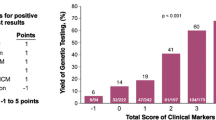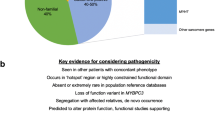Abstract
Building on seminal studies of the last 20 years, genetic testing for hypertrophic cardiomyopathy (HCM) has become a clinical reality in the form of targeted exonic sequencing of known disease-causing genes. This has been driven primarily by the decreasing cost of sequencing, but the high profile of genome-wide association studies, the launch of direct-to-consumer genetic testing, and new legislative protection have also played important roles. In the clinical management of hypertrophic cardiomyopathy, genetic testing is primarily used for family screening. An increasing role is recognized, however, in diagnostic settings: in the differential diagnosis of HCM; in the differentiation of HCM from hypertensive or athlete’s heart; and more rarely in preimplantation genetic diagnosis. Aside from diagnostic clarification and family screening, use of the genetic test for guiding therapy remains controversial, with data currently too limited to derive a reliable mutation risk prediction from within the phenotypic noise of different modifying genomes. Meanwhile, the power of genetic testing derives from the confidence with which a mutation can be called present or absent in a given individual. This confidence contrasts with our more limited ability to judge the significance of mutations for which co-segregation has not been demonstrated. These variants of “unknown” significance represent the greatest challenge to the wider adoption of genetic testing in HCM. Looking forward, next-generation sequencing technologies promise to revolutionize the current approach as whole genome sequencing will soon be available for the cost of today’s targeted panel. In summary, our future will be characterized not by lack of genetic information but by our ability to effectively parse it.


Similar content being viewed by others
References
Jones, W. H. S. (1923). Hippocratic collection vol 1-8. Cambridge: Harvard University Press.
Bateson, W. (1902). Mendel’s principles of heredity, a defense. London: Cambridge University Press.
Mendel, G. (1901). Experiments in plant hybridizaton (English translation). Journal of the Royal Horticultural Society, 26, 1–32.
Kerem, B., Rommens, J. M., Buchanan, J. A., et al. (1989). Identification of the cystic fibrosis gene: genetic analysis. Science, 245(4922), 1073–1080.
Curran, M. E., Splawski, I., Timothy, K. W., Vincent, G. M., Green, E. D., & Keating, M. T. (1995). A molecular basis for cardiac arrhythmia: HERG mutations cause long QT syndrome. Cell, 80(5), 795–803.
Wang, Q., Shen, J., Splawski, I., et al. (1995). SCN5A mutations associated with an inherited cardiac arrhythmia, long QT syndrome. Cell, 80(5), 805–811.
Geisterfer-Lowrance, A. A., Kass, S., Tanigawa, G., et al. (1990). A molecular basis for familial hypertrophic cardiomyopathy: a beta cardiac myosin heavy chain gene missense mutation. Cell, 62(5), 999–1006.
Burton, P. R., Clayton, D. G., Cardon, L. R., Craddock, N., Deloukas, P., Duncanson, A., et al. (2007). Genome-wide association study of 14, 000 cases of seven common diseases and 3, 000 shared controls. Nature, 447(7145), 661–678.
Hudson, K., Javitt, G., Burke, W., & Byers, P. (2007). ASHG Statement* on direct-to-consumer genetic testing in the United States. Obstetrics and Gynecology, 110(6), 1392–1395.
Altman, R. B. (2009). Direct-to-consumer genetic testing: failure is not an option. Clinical Pharmacology and Therapeutics, 86(1), 15–17.
Hershberger, R. E., Lindenfeld, J., Mestroni, L., Seidman, C. E., Taylor, M. R., & Towbin, J. A. (2009). Genetic evaluation of cardiomyopathy–a Heart Failure Society of America practice guideline. Journal of Cardiac Failure, 15(2), 83–97.
Marston, S., Copeland, O., Jacques, A., et al. (2009). Evidence from human myectomy samples that MYBPC3 mutations cause hypertrophic cardiomyopathy through haploinsufficiency. Circulation Research, 105(3), 219–222.
Seidman, J. G., & Seidman, C. (2001). The genetic basis for cardiomyopathy: from mutation identification to mechanistic paradigms. Cell, 104(4), 557–567.
Bos, J. M., Towbin, J. A., & Ackerman, M. J. (2009). Diagnostic, prognostic, and therapeutic implications of genetic testing for hypertrophic cardiomyopathy. Journal of the American College of Cardiology, 54(3), 201–211.
Frazer, K. A., Ballinger, D. G., Cox, D. R., et al. (2007). A second generation human haplotype map of over 3.1 million SNPs. Nature, 449(7164), 851–861.
International HapMap Consortium. (2005). A haplotype map of the human genome. Nature, 437(7063), 1299–1320.
International HapMap Consortium. (2003). The International HapMap Project. Nature, 426(6968), 789–796.
Lander, E. S., Linton, L. M., Birren, B., et al. (2001). Initial sequencing and analysis of the human genome. Nature, 409(6822), 860–921.
Venter, J. C., Adams, M. D., Myers, E. W., et al. (2001). The sequence of the human genome. Science, 291(5507), 1304–1351.
McCarthy, M. I., Abecasis, G. R., Cardon, L. R., et al. (2008). Genome-wide association studies for complex traits: consensus, uncertainty and challenges. Nature Reviews. Genetics, 9(5), 356–369.
Frazer, K. A., Murray, S. S., Schork, N. J., & Topol, E. J. (2009). Human genetic variation and its contribution to complex traits. Nature Reviews. Genetics, 10(4), 241–251.
Storey, J. D., & Tibshirani, R. (2003). Statistical significance for genomewide studies. Proceedings of the National Academy of Sciences of the United States of America, 100(16), 9440–9445.
Maron, B. J., McKenna, W. J., Danielson, G. K., et al. (2003). American College of Cardiology/European Society of Cardiology clinical expert consensus document on hypertrophic cardiomyopathy. A report of the American College of Cardiology Foundation Task Force on Clinical Expert Consensus Documents and the European Society of Cardiology Committee for Practice Guidelines. Journal of the American College of Cardiology, 42(9), 1687–1713.
Maron, B. J., Spirito, P., Wesley, Y., & Arce, J. (1986). Development and progression of left ventricular hypertrophy in children with hypertrophic cardiomyopathy. New England Journal of Medicine, 315(10), 610–614.
European Society of Human Genetics. (2009). Genetic testing in asymptomatic minors: Recommendations of the European Society of Human Genetics. European Journal of Human Genetics, 7(6), 720–721.
Maron, B. J., Roberts, W. C., Arad, M., et al. (2009). Clinical outcome and phenotypic expression in LAMP2 cardiomyopathy. Jama, 301(12), 1253–1259.
Arad, M., Maron, B. J., Gorham, J. M., et al. (2005). Glycogen storage diseases presenting as hypertrophic cardiomyopathy. New England Journal of Medicine, 352(4), 362–372.
Hamour, I. M., Lachmann, H. J., Goodman, H. J., et al. (2008). Heart transplantation for homozygous familial transthyretin (TTR) V122I cardiac amyloidosis. American Journal of Transplantation, 8(5), 1056–1059.
Dubrey, S. W., Burke, M. M., Khaghani, A., Hawkins, P. N., Yacoub, M. H., & Banner, N. R. (2001). Long term results of heart transplantation in patients with amyloid heart disease. Heart (British Cardiac Society)., 85(2), 202–207.
Schiffmann, R., Kopp, J. B., Austin, H. A., 3rd, et al. (2001). Enzyme replacement therapy in Fabry disease: a randomized controlled trial. Jama, 285(21), 2743–2749.
Eng, C. M., Guffon, N., Wilcox, W. R., et al. (2001). Safety and efficacy of recombinant human alpha-galactosidase A–replacement therapy in Fabry's disease. New England Journal of Medicine, 345(1), 9–16.
Buja, L. M. (2009). Evaluation of recombinant alpha-galactosidase A therapy for amelioration of the cardiovascular manifestations of Fabry disease: an important role for endomyocardial biopsy. Circulation, 119(19), 2539–2541.
Goldenberg, I., Zareba, W., & Moss, A. J. (2008). Long QT Syndrome. Current Problems in Cardiology, 33(11), 629–694.
Roden, D. M. (2008). Clinical practice. Long-QT syndrome. New England Journal of Medicine, 358(2), 169–176.
Lehnart, S. E., Ackerman, M. J., Benson, D. W., Jr., et al. (2007). Inherited arrhythmias: a National Heart, Lung, and Blood Institute and Office of Rare Diseases workshop consensus report about the diagnosis, phenotyping, molecular mechanisms, and therapeutic approaches for primary cardiomyopathies of gene mutations affecting ion channel function. Circulation, 116(20), 2325–2345.
Watkins, H., McKenna, W. J., Thierfelder, L., et al. (1995). Mutations in the genes for cardiac troponin T and alpha-tropomyosin in hypertrophic cardiomyopathy. New England Journal of Medicine, 332(16), 1058–1064.
Watkins, H., Rosenzweig, A., Hwang, D. S., et al. (1992). Characteristics and prognostic implications of myosin missense mutations in familial hypertrophic cardiomyopathy. New England Journal of Medicine, 326(17), 1108–1114.
Marian, A. J., Yu, Q. T., Workman, R., Greve, G., & Roberts, R. (1993). Angiotensin-converting enzyme polymorphism in hypertrophic cardiomyopathy and sudden cardiac death. Lancet, 342(8879), 1085–1086.
van der Merwe, L., Cloete, R., Revera, M., et al. (2008). Genetic variation in angiotensin-converting enzyme 2 gene is associated with extent of left ventricular hypertrophy in hypertrophic cardiomyopathy. Human Genetics, 124(1), 57–61.
Perkins, M. J., Van Driest, S. L., Ellsworth, E. G., et al. (2005). Gene-specific modifying effects of pro-LVH polymorphisms involving the renin-angiotensin-aldosterone system among 389 unrelated patients with hypertrophic cardiomyopathy. European Heart Journal, 26(22), 2457–2462.
Fermin, D., Barac, A., Lee, S., et al. (2008). Sex and age dimorphism of myocardial gene expression in nonischemic human heart failure. Circ Cardiov Genetics., 1, 117–125.
Lind, J. M., Chiu, C., Ingles, J., et al. (2008). Sex hormone receptor gene variation associated with phenotype in male hypertrophic cardiomyopathy patients. Journal of Molecular and Cellular Cardiology, 45(2), 217–222.
Maron, B. J., & Ho, C. Y. (2009). Hypertrophic cardiomyopathy without hypertrophy: an emerging pre-clinical subgroup composed of genetically affected family members. Jacc, 2(1), 65–68.
Semsarian, C., Ahmad, I., Giewat, M., et al. (2002). The L-type calcium channel inhibitor diltiazem prevents cardiomyopathy in a mouse model. Journal of Clinical Investigation, 109(8), 1013–1020.
Handyside, A. H., Kontogianni, E. H., Hardy, K., & Winston, R. M. (1990). Pregnancies from biopsied human preimplantation embryos sexed by Y-specific DNA amplification. Nature, 344(6268), 768–770.
PGDIS. (2008). Guidelines for good practice in PGD: programme requirements and laboratory quality assurance. Reproductive Biomedicine Online, 16(1), 134–147.
Basille, C., Frydman, R., El Aly, A., et al. (2009). Preimplantation genetic diagnosis: state of the art. European Journal of Obstetrics, Gynecology, and Reproductive Biology, 145(1), 9–13.
Krahn, T. (2009). Preimplantation genetic diagnosis: does age of onset matter (anymore)? Medicine, Health Care and Philosophy, 12(2), 187–202.
McArthur, S. J., Leigh, D., Marshall, J. T., Gee, A. J., De Boer, K. A., & Jansen, R. P. (2008). Blastocyst trophectoderm biopsy and preimplantation genetic diagnosis for familial monogenic disorders and chromosomal translocations. Prenatal Diagnosis, 28(5), 434–442.
Richards, C. S., Bale, S., Bellissimo, D. B., et al. (2008). ACMG recommendations for standards for interpretation and reporting of sequence variations: Revisions 2007. Genetics in Medicine, 10(4), 294–300.
Sunyaev, S., Ramensky, V., Koch, I., Lathe, W., 3rd, Kondrashov, A. S., & Bork, P. (2001). Prediction of deleterious human alleles. Human Molecular Genetics, 10(6), 591–597.
Kumar, P., Henikoff, S., & Ng, P. C. (2009). Predicting the effects of coding non-synonymous variants on protein function using the SIFT algorithm. Nature protocols., 4(8), 1073–1081.
Sanger, F., Air, G. M., Barrell, B. G., et al. (1977). Nucleotide sequence of bacteriophage phi X174 DNA. Nature, 265(5596), 687–695.
Shendure, J., & Ji, H. (2008). Next-generation DNA sequencing. Nature Biotechnology, 26(10), 1135–1145.
Braslavsky, I., Hebert, B., Kartalov, E., & Quake, S. R. (2003). Sequence information can be obtained from single DNA molecules. Proceedings of the National Academy of Sciences of the United States of America, 100(7), 3960–3964.
Pushkarev, D., Neff, N. F., & Quake, S. R. (2009). Single-molecule sequencing of an individual human genome. Nature Biotechnology, 27(9), 847–852.
Eid, J., Fehr, A., Gray, J., et al. (2009). Real-time DNA sequencing from single polymerase molecules. Science, 323(5910), 133–138.
Kim, J. B., Porreca, G. J., Song, L., et al. (2007). Polony multiplex analysis of gene expression (PMAGE) in mouse hypertrophic cardiomyopathy. Science, 316(5830), 1481–1484.
Author information
Authors and Affiliations
Corresponding author
Rights and permissions
About this article
Cite this article
Wheeler, M., Pavlovic, A., DeGoma, E. et al. A New Era in Clinical Genetic Testing for Hypertrophic Cardiomyopathy. J. of Cardiovasc. Trans. Res. 2, 381–391 (2009). https://doi.org/10.1007/s12265-009-9139-0
Received:
Accepted:
Published:
Issue Date:
DOI: https://doi.org/10.1007/s12265-009-9139-0




